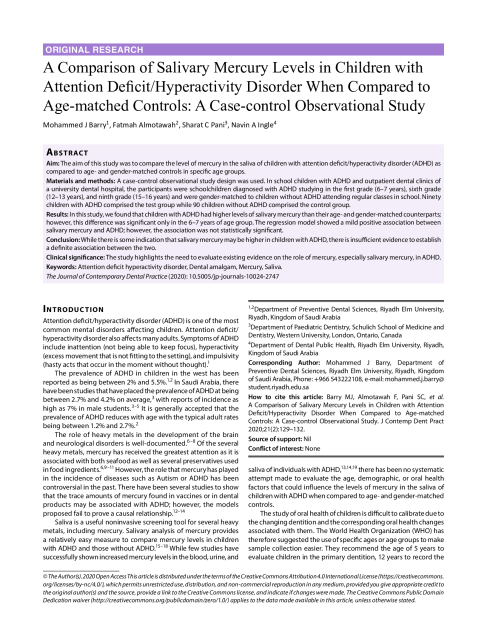A Comparison of Salivary Mercury Levels in Children with Attention Deficit/Hyperactivity Disorder When Compared to Age-matched Controls: A Case-control Observational Study

- Mohammed J Barry
- Fatmah Almotawah
- Sharat C Pani
- Navin A Ingle
The Journal of Contemporary Dental Practice
10.5005/jp-journals-10024-2747Abstract
Aim: The aim of this study was to compare the level of mercury in the saliva of children with attention deficit/hyperactivity disorder (ADHD) as compared to age- and gender-matched controls in specific age groups.
Materials and methods: A case-control observational study design was used. In school children with ADHD and outpatient dental clinics of a university dental hospital, the participants were schoolchildren diagnosed with ADHD studying in the first grade (6-7 years), sixth grade (12-13 years), and ninth grade (15-16 years) and were gender-matched to children without ADHD attending regular classes in school. Ninety children with ADHD comprised the test group while 90 children without ADHD comprised the control group.
Results: In this study, we found that children with ADHD had higher levels of salivary mercury than their age- and gender-matched counterparts; however, this difference was significant only in the 6-7 years of age group. The regression model showed a mild positive association between salivary mercury and ADHD; however, the association was not statistically significant.
Conclusion: While there is some indication that salivary mercury may be higher in children with ADHD, there is insufficient evidence to establish a definite association between the two.
Clinical significance: The study highlights the need to evaluate existing evidence on the role of mercury, especially salivary mercury, in ADHD.
Keywords
Attention deficit hyperactivity disorder, Dental amalgam, Mercury, SalivaCitation
Barry, M.J., Almotawah, F., Pani, S.C., & Ingle, N.A. (). A Comparison of Salivary Mercury Levels in Children with Attention Deficit/Hyperactivity Disorder When Compared to Age-matched Controls: A Case-control Observational Study. J Contemp Dent Pract, 21(2), 129-132, doi: 10.5005/jp-journals-10024-2747
Link to this page: https://res.adhd.org.sa/doi/10.5005/jp-journals-10024-2747